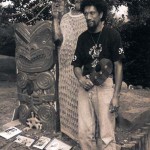34
Artist: Carver Mutu Bryan
Year: 1999
Medium: Traditional Carving
Size: Approx 6 ft

These two carvings represent the carver’s great paternal grandparents. They are Witeri great grandfather – the carved figure and Mokomoko great grandmother – the traditionally carved panel.
Witeri courted Mokomoko on the islands of Motiti, Matakana and Tuhua (Mayor Island). It was Mokomoko’s decision to move to Tuapiro north of Katikati. Of the ten children born to them Mutu’s grandmother Mikaere, was the fifth child. She is portrayed on the traditional panel.
Witeri and Mokomoko were a kind and humble couple. They laboured to be good providers for their children, extended whanua (family) and members of the marae. They lived off the land, hunted, fishing and gathering shellfish. As keen gardeners they grew a variety of vegetables, fruit from the orchard and flower gardens.
The standing figure of Witeri is clothed in a Kiwi-feathered cloak. His handle-bar moustache was copied from the europeans and was a fashion of the times. His hand is raised representing the Ringatu Religion, one of the first in New Zealand.
Mokomoko is represented as a panel carved in the tradition of the Mataatua style. This Pou-Pou (panel), a significant carving, usually lines the walls of the Wharepuna (ancestal house). Mokomoko was from Opotiki. Her tribe was Whakatohea. A quietly spoken woman with a heart of gold who cared for all who came to their home.
They died a year apart. Witeri died on May7, 1933 and his body was taken by boat, horse and sled from Tuapiro to the old cemetery on Bowentown Hill.
Because of the deterioration of the timber, the carving were returned to their whanau at the Tuapiro Marae in 2007 .



